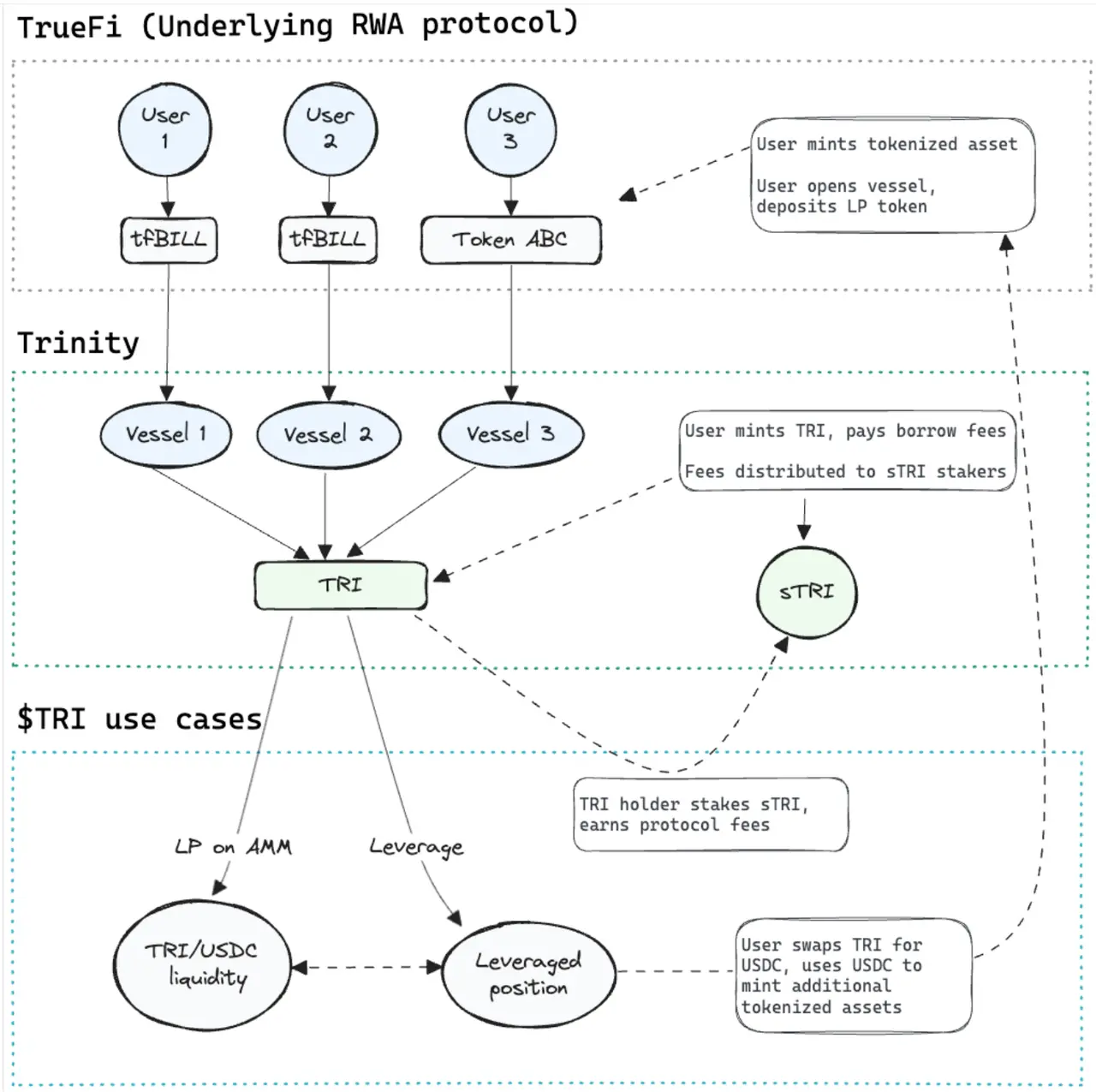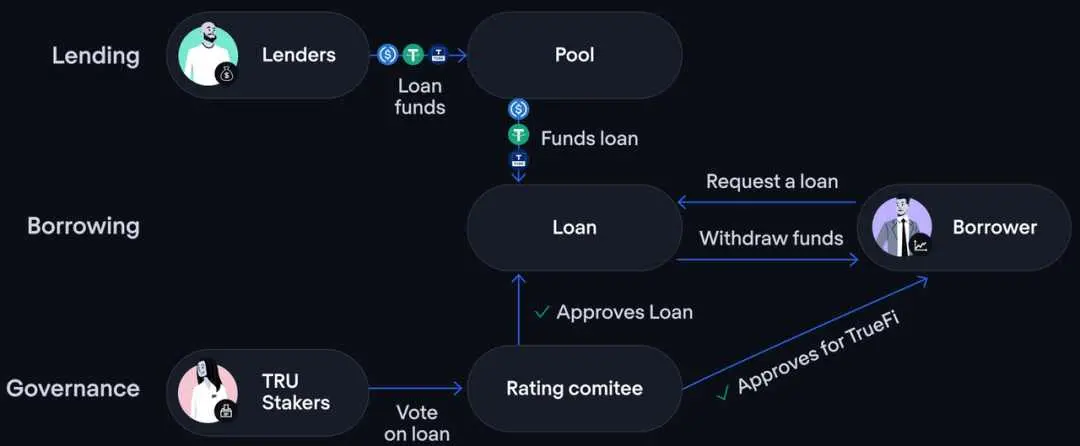The launch of the beta version has sparked widespread market participation. Can TrueFi lead the innovation in RWA?
In the wave of decentralized finance (DeFi), TrueFi stands at the forefront of innovation. As the first and largest credit protocol in the DeFi space, TrueFi not only reshapes the infrastructure of lending and credit but also continuously explores new possibilities. Recently, TrueFi announced a significant advancement—introducing the Trinity protocol on the Base blockchain.
This new protocol aims to simplify the process for users to obtain leverage and hedge risks through the TRI token—a dollar-pegged digital currency backed by collateralized assets. The beta version of the Trinity protocol has been launched on the Optimism Sepolia testnet and is planned to be opened to a selected user group after a rigorous audit. This strategic move is expected to set the minting cap for TRI tokens at $40 million, marking a new step for TrueFi in the on-chain asset trading space.

The launch of the Trinity protocol not only demonstrates TrueFi's commitment to DeFi innovation but also provides users with more financial tools and opportunities. Next, we will delve into the specifics of the Trinity protocol, including how it utilizes tokenized short-term U.S. Treasury bill products, tfBILL, as collateral, and how users can gain leverage, hedge risks, and achieve efficient capital utilization through this new protocol.
Creating a New Paradigm for RWA Assets with Innovative Financial Tools and Flexible Yield Strategies
In the world of decentralized finance (DeFi), TrueFi has been dedicated to driving innovation and enhancing the capital efficiency of on-chain assets. Recently, TrueFi introduced the Trinity protocol, which aims to simplify the process for users to obtain leverage and hedge risks through the TRI token—a dollar-pegged digital currency backed by collateralized assets. This innovation not only signifies TrueFi's revitalization of real-world asset (RWA) trading but also heralds a significant breakthrough in the on-chain asset trading space.
The core of the Trinity protocol lies in its use of tfBILL—a tokenized short-term U.S. Treasury bill product, which is one of the first collateralized assets supporting the TRI token. In addition to tfBILL, users can also utilize other assets from the TrueFi pool, RWAs from different protocols, and crypto-native assets as collateral. This diversified selection of collateral not only increases user flexibility but also significantly enhances capital utilization efficiency.
By using tfBILL or other assets to mint TRI on Trinity, users can exchange it for stablecoins on automated market makers, thereby borrowing up to 92% loan-to-value ratio of TRI and achieving net yields of 15-20%. Additionally, users can choose to exchange stablecoins for TRI and deposit them into the sTRI vault to earn yields comparable to or even higher than Treasury bill rates. The secondary market trading of TRI tokens further increases users' operational flexibility and yield potential.

Although the market size for on-chain RWAs is currently only one-third of its peak, TrueFi demonstrates firm confidence in market recovery through the launch of the Trinity protocol. The Trinity protocol has been launched on the Optimism Sepolia testnet and is expected to open to selected users after the audit, with a minting cap of $40 million. Furthermore, TrueFi plans to launch Trinity on Coinbase's Layer 2 Base network, although the initial deployment will not be available to U.S. users. This strategic deployment indicates TrueFi's further expansion and enhanced influence in the global DeFi ecosystem.
Since launching its first protocol in 2020, TrueFi has issued $1 billion in loans, and its continuous innovation and expansion are shaping the future of the DeFi space. With the launch and implementation of the Trinity protocol, TrueFi not only provides users with new financial tools and opportunities but also injects new vitality and potential into the entire DeFi ecosystem.
A Comprehensive Introduction to TrueFi's Product System and Development History: Bringing Debt On-Chain, Now Iterated to Version 5
TrueFi, meticulously crafted by the Archblock team (formerly TrustToken), marks a significant leap in the field of uncollateralized lending within DeFi. As the core infrastructure of the digital asset credit market, TrueFi utilizes smart contracts managed by the TRU token to achieve seamless connections between lenders, borrowers, and portfolio managers. Unlike traditional protocols that require collateral, such as Aave, Compound, and Venus, TrueFi provides lenders with a collateral-free, predictive loan rate environment. Its grand vision is to establish a market-driven, fully automated credit rating and lending system, breaking traditional minimum/maximum APY limits and high TRU participation thresholds while enhancing users' sense of responsibility in approving new borrowers and loan types.
TrueFi aims to make credit more accessible, transparent, and programmable by bringing debt infrastructure on-chain, with the following core advantages:
- Maximum transparency: TrueFi allows real-time tracking of every dollar lent to borrowers;
- Diverse opportunities: TrueFi serves borrowers and portfolio managers (PMs) across multiple verticals, including "real-world" use cases and crypto-focused institutions;
- User-centric: TRU holders manage the protocol, approve new PMs and borrowers, and oversee key financial and cooperative decisions;
- TRU governance token: TRU is used for governance of the protocol and for approving new managers and borrowers;
- Market access: TrueFi's tokens are listed on multiple markets, including Coinbase, Binance, and Sushiswap.

The development timeline of the TrueFi project is as follows:
- Initial Phase: In February 2018, TrueFi raised approximately $28 million through the Pre-Sale phase on CoinList;
- Launch of Version 1: In November 2020, the first version was released, initially supporting credit loans based on TUSD;
- Upgrade to Version 2: Between November 2020 and February 2021, the "liquid exit" feature was introduced, optimizing the staking model and achieving full on-chain governance;
- Development of Version 3: From March to May 2021, a USDC pool was added, the credit model was improved, and loan token trading was allowed;
- Expansion to Version 4: From June to August 2021, support for any ERC-20 token was added, allowing other lending protocols to provide liquidity, launching a USDT pool, and establishing SAFU;
- Version 5 to Present: Since September 2021, deployed on Layer 2, supporting "protocol-to-protocol" lending, launching non-stablecoin lending products in collaboration with Woo Network, and refining stablecoin lending pools.
TrueFi aims to serve both depositors and borrowers. Any user holding USDC/USDT/TUSD/BUSD can deposit stablecoins and choose lending pools for investment to earn returns. TrueFi has two main business lines—TrueFi DAO Pools and TrueFi Capital Markets. The former focuses on stablecoin credit loans, with risk management jointly handled by TrueFi stakers and the TrueFi rating committee; the latter includes both stablecoin and non-stablecoin credit loans, managed by external managers responsible for specific business risk control.
The Development of RWA Assets is Still in Its Early Stages, with Many Uncertainties Ahead
In exploring the vast realm of decentralized finance (DeFi), the field of uncollateralized lending is undoubtedly one of the most attractive frontiers. Through this in-depth analysis of leading projects like TrueFi, we gain insight into the immense potential of this field and the practical challenges it faces. Despite the significant demand for uncollateralized lending in the market, effectively addressing the "deadbeat" problem and ensuring the security of loans remains an unresolved issue.
TrueFi attempts to build a safer and more transparent lending environment by introducing KYC processes and utilizing information provided by borrowers (such as bank transaction records, third-party credit rating data, or potential DID digital identities) to screen and assess borrowers. Additionally, establishing partnerships through smart contracts and possible legal agreements provides some assurance for debt recovery in case of defaults. However, in the decentralized world, the realization of recourse rights remains a challenge, and over-collateralized lending models still seem to be the "safe haven" in the DeFi space.
Nevertheless, projects like TrueFi demonstrate the feasibility and potential of uncollateralized lending models by starting with institutional borrowers to reduce default risks, providing relatively robust yield guarantees for DeFi lenders. This gradual expansion from institutions to a broader user base, while full of challenges, also brings new development opportunities to the DeFi space.
The exploration of uncollateralized lending, though fraught with difficulties, paints a bright future for DeFi through these relentless attempts and efforts. As highlighted by DeFi Prime's review of projects in this field earlier this year, while some projects have disappeared, the exploration has never ceased. For TrueFi and other pioneers, every attempt and breakthrough is a step towards a new DeFi frontier. In the future, what awaits is a more open, secure, and full of possibilities DeFi world.









